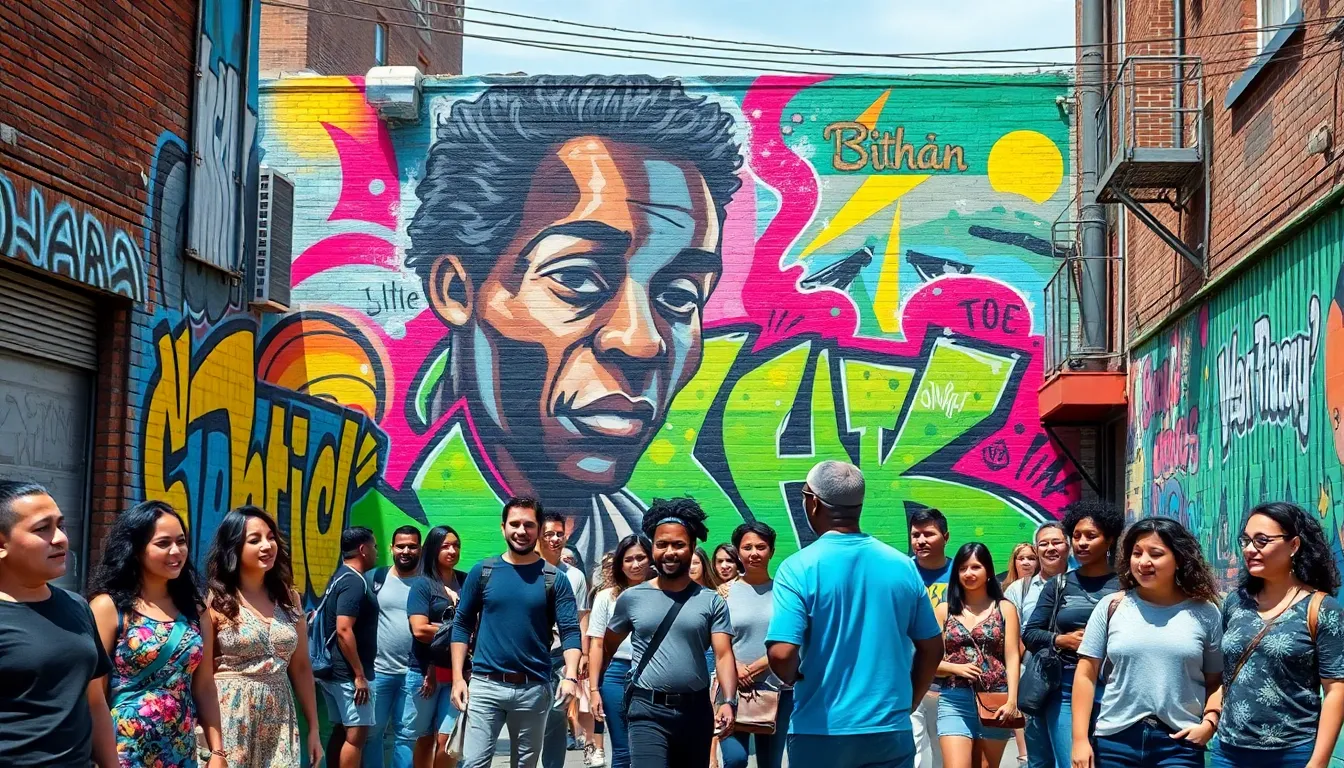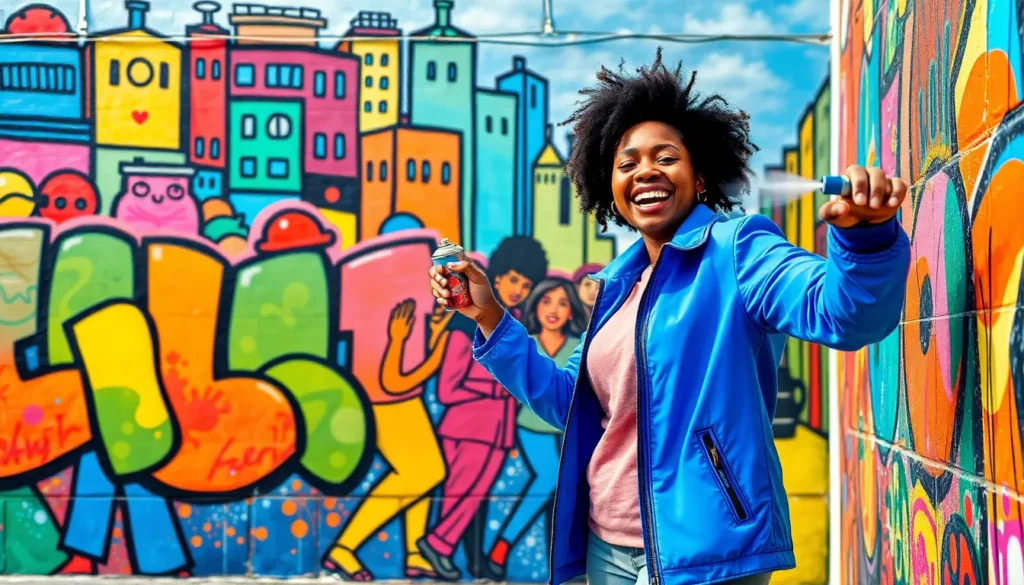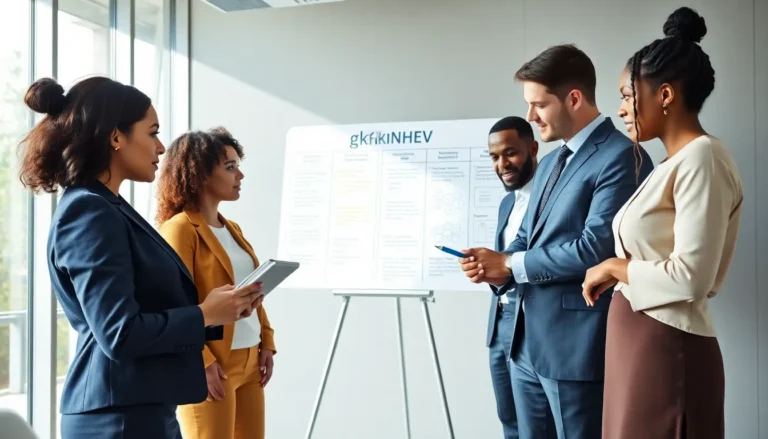Graffiti murals are more than just splashes of color on dull walls; they’re vibrant stories waiting to be told. Imagine strolling through a city and stumbling upon a massive mural that grabs your attention and makes you smile. These larger-than-life artworks transform ordinary spaces into extraordinary experiences, inviting everyone to pause and appreciate the creativity around them.
Table of Contents
ToggleThe Evolution of Graffiti Murals
Graffiti murals have experienced significant transformation over the years, reflecting societal changes and artistic growth. Their evolution illustrates a journey from simple tagging to complex community-driven masterpieces.
Historical Background
Graffiti originated as a form of expression in ancient civilizations, with examples found in Egypt and Rome. The late 20th century saw a resurgence in urban areas, particularly during the 1970s in New York City. Street artists used public spaces to voice their opinions and address social issues. This movement emerged alongside hip-hop culture, emerging as a powerful medium for marginalized voices. Legal recognition came in the 1980s, as cities began to embrace graffiti as a legitimate form of art, further evolving its public perception.
Influential Styles and Techniques
Diverse styles characterize graffiti murals, with each artist contributing unique techniques. Lettering styles, such as Wildstyle, utilize intricate connections between letters. Artists also apply spray paint for vivid colors and layered effects, creating depth and movement. Some incorporate stencils for precision, while others prefer freehand applications for spontaneity. Murals often reflect cultural influences, integrating elements from pop art, surrealism, or abstract forms. Techniques, such as character development, enhance narratives within these expansive artworks, engaging viewers and sparking conversation.
Cultural Significance of Graffiti Murals

Graffiti murals carry deep cultural significance, reflecting diverse narratives and social commentary. These artworks play a vital role in urban landscapes.
Social Commentary and Expression
Artists utilize graffiti murals to provide social commentary, addressing issues like inequality and political corruption. They serve as platforms for communities to voice concerns, reflect on societal struggles, and challenge the status quo. Through powerful imagery and thought-provoking messages, murals can evoke strong emotions and inspire dialogue among viewers. Important community issues often find a voice in this expressive form of art, contributing to greater awareness and engagement.
Community Identity and Pride
Graffiti murals foster a sense of community identity and pride. Local artists often draw inspiration from cultural heritage, representing backgrounds and traditions unique to neighborhoods. As a result, these vibrant displays become sources of collective pride, connecting residents to their environment. They can also attract tourism, promoting community initiatives and local businesses. Engaging with the artwork enhances cultural understanding while strengthening the bond between residents and their surroundings.
Prominent Artists in the Graffiti Mural Scene
Several artists stand out in the graffiti mural scene, showcasing immense talent and creativity.
Interviews and Insights
Many prominent graffiti muralists share their journeys through interviews. They discuss motivations for their art, often citing personal experiences. A respected artist like Banksy uses anonymity to convey political statements, stirring public interest. Another artist, Shepard Fairey, emphasizes the role of social activism in his vibrant pieces. Both artists inspire upcoming talents by discussing challenges and successes. Insights reveal that community engagement significantly influences their work, helping to address local issues.
Notable Works and Their Impact
Notable works have shaped public perceptions of graffiti murals. “Girl with a Balloon” by Banksy became iconic, symbolizing hope amidst adversity. Shepard Fairey’s “Hope” poster played a significant role in the 2008 presidential campaign, showcasing art’s power in political contexts. These murals often spark conversations about social justice and identity. Additionally, community murals like “The Grand Street Bridge” in Brooklyn highlight local artists’ talents, enriching urban landscapes. Their impact extends beyond aesthetics, promoting community dialogues and cultural pride.
Legal and Ethical Considerations
Understanding the legal and ethical dimensions of graffiti murals is crucial for artists and communities alike. The distinction between vandalism and street art plays a significant role in shaping public perceptions.
Vandalism vs. Street Art
Vandalism occurs when individuals create unauthorized artwork on property without consent from owners. This illegal activity results in legal consequences and damages public space. Street art, in contrast, represents creative expression that often receives community support and approval. Numerous cities recognize the value of murals by designating legal walls where artists can freely paint. The line between vandalism and street art blurs when artworks provoke discussions about their message or context. Effective dialogue around these forms fosters appreciation for artistic expression while respecting property rights.
Working with Local Authorities
Engaging local authorities remains essential for successful mural projects. Collaboration with city officials helps secure permits and navigate regulations governing public art. Various municipalities offer programs that support artists in obtaining necessary approvals. Establishing connections with neighborhood councils can further facilitate project acceptance. Local agencies often encourage community input, ensuring that murals align with residents’ values. Building relationships with authorities promotes transparency, enhancing the chance of project longevity. By working together, artists and local governments can create vibrant spaces that celebrate community identity and promote cultural development.
The Future of Graffiti Murals
Graffiti murals continue evolving, reflecting contemporary culture and community values. Emerging trends indicate exciting directions for this vibrant art form.
Trends and Innovations
Innovative techniques reshape how artists approach murals. Use of eco-friendly spray paints aligns with sustainability efforts. Artists often experiment with augmented reality, integrating digital elements that enhance viewer interaction. Community participation in mural creation increases, fostering a deeper connection between the artwork and local residents. This collaborative approach not only enriches the mural’s narrative but also ensures relevance within the community. Moreover, interactive murals that respond to viewer engagement attract more attention, reinforcing the importance of accessibility.
The Role of Technology
Technology significantly influences the future of graffiti murals. Digital tools simplify design processes for artists, allowing for rapid visualizations. Graphic design software enables seamless planning and implementation, reducing errors in execution. Social media platforms play a crucial role in promoting artists and showcasing projects, expanding their reach beyond local audiences. Additionally, drone technology aids in large-scale mural production, providing an aerial perspective for detailed execution. Incorporating virtual reality experiences offers viewers immersive opportunities to engage with the mural’s content in new ways.
Graffiti murals stand as powerful symbols of creativity and community expression. They breathe life into urban spaces while fostering dialogue around social issues. As artists continue to innovate and engage with their neighborhoods, these vibrant artworks will undoubtedly shape the cultural landscape for years to come.
The future of graffiti murals promises exciting developments driven by technology and community involvement. As techniques evolve and the dialogue around street art expands, these murals will remain essential in connecting people to their environments. Ultimately, they serve as a reminder of the transformative power of art in society.



